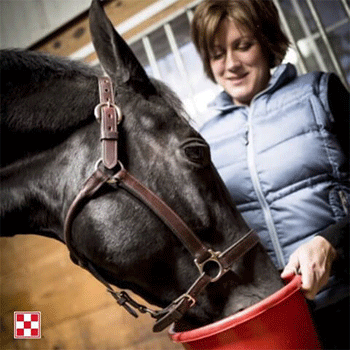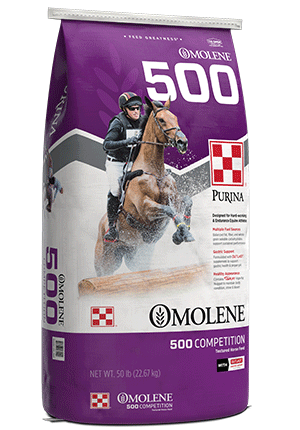
Horses Don’t Eat Feed Tags
Nutrition : General Nutrition
Nutrition : Ingredients & Nutrients

Reading, comparing and understanding horse feed tags or labels to help determine which horse feed to purchase can be a daunting task.
Not only do you need a little background knowledge about nutrition terminology, but you also need a good understanding of horse nutrient requirements to make sense of it all. Because a feed tag is required by law to be on every bag of commercial horse feed, it is the only consistent information available to make comparisons across all brands. However, there are limits to what can be included on horse feed tag and it’s important to understand what you can and cannot determine from the information presented.
Feed tags are legal documents regulated by the Association of American Feed Control Officials (AAFCO), as well as individual state regulatory agencies and the U.S. Food and Drug Administration (FDA). AAFCO publishes an official document each year outlining feed labeling requirements for all animal feeds.What a horse feed tag tells you:
While the regulatory agencies require a feed tag meeting each individual state’s label requirements, that tag does not provide all the information necessary to make the most informed feed decision. We are glad “horses don’t eat feed tags,” because we know feed tag information doesn’t tell the full story, either nutritionally or how that feed will perform. At the end of the day, the most accurate indicator of a good quality feed is how a horse looks, feels and performs.
Our expert Purina horse feed team includes six PhDs and a DVM who make it a priority to produce top quality products exceeding our customers’ expectations. We do this by focusing on things not found on a feed tag:
Not only do you need a little background knowledge about nutrition terminology, but you also need a good understanding of horse nutrient requirements to make sense of it all. Because a feed tag is required by law to be on every bag of commercial horse feed, it is the only consistent information available to make comparisons across all brands. However, there are limits to what can be included on horse feed tag and it’s important to understand what you can and cannot determine from the information presented.
Feed tags are legal documents regulated by the Association of American Feed Control Officials (AAFCO), as well as individual state regulatory agencies and the U.S. Food and Drug Administration (FDA). AAFCO publishes an official document each year outlining feed labeling requirements for all animal feeds.
What a horse feed tag tells you:
- Product name and weight – an obvious, but nevertheless important piece of information.
- Purpose statement identifying the type of horse intended to be fed – a surprisingly large number of horse owners do not pay attention to this. Checking that your feed has been specifically formulated for your class of horse is critical. For example, you would not want to feed a product designed for a “mature horse at maintenance” to a “young growing horse.”
- Guaranteed analysis of certain nutrients – AAFCO dictates the following nutrient guarantees to be listed for all fortified horse feeds: Crude Protein (minimum), Crude Fat (minimum), Crude Fiber (maximum), Acid Detergent Fiber (ADF) (maximum), Neutral Detergent Fiber (NDF) (maximum), Calcium (minimum and maximum), Phosphorus (minimum), Copper (minimum) (if added), Selenium (minimum), Zinc (minimum), and Vitamin A (minimum) (if added). Sugar (maximum) and Starch (maximum) guarantees are also required on any horse feed including carbohydrate claims on the packaging and/or marketing materials. All nutrients guaranteed on the tag are potentially subject to testing by regulatory agencies to determine whether the tag guarantees are accurate.
- Ingredient list – this listing may include individual ingredients (e.g. oats, rice bran, etc.) and/or collective terms (e.g. grain products or processed grain by-products). In most states, the feed manufacturer determines the ingredient terminology; however, some states require individual ingredients on horse feed labels. Some horse owners feel an ingredient list including ingredients means the manufacturer is “locking” or “fixing” the feed formula, while collective terms indicate the feed formula is using “least cost” formulation. The ingredient list does not provide insight to the formulation strategy utilized for any given feed product. Further, individual versus collective terms do not yield information regarding quality of ingredients in a feed. Ingredients are required to be listed in descending order of inclusion. However, there are no reliable analyses to determine exact amounts of ingredients, or even clearly distinguish specifically which ingredients are included, so it’s difficult for regulatory agencies to monitor compliance to this law.
- Feeding directions – again, a surprising number of horse owners do not read the feeding directions. Horse feed manufacturers formulate feeds to be fed at a specific range of feeding rates; when a product is not fed according to the directions, the full nutritional benefits of that feed may not be realized and the feed will not perform as intended.
What a horse feed tag does not tell you:
- Additional nutrients needed by the horse but aren’t required to be guaranteed on the tag – some manufacturers choose to include nutrient guarantees beyond those required by AAFCO or individual states; horse owners sometimes compare guaranteed analyses and feel more, or higher, nutrient guarantees mean improved nutrition for their horses. However, even if a nutrient is not guaranteed on the feed tag, it doesn’t necessarily mean the nutrient isn’t in the feed. Many manufacturers provide a completely balanced ration including many more nutrients than listed in the guarantee. State regulatory agencies often perform analyses on nutrients required to be listed; some may also test additional guaranteed nutrients, but it’s not required. The state is less likely to test for nutrients not required to be listed and some nutrients are quite expensive to assay (such as amino acids, vitamins and various feed additives), so compliance with those additional guarantees is not as reliable as for those required to be listed.
- Nutrient and ingredient quality or bioavailability – The total amount of protein listed on the tag (i.e. 14% crude protein) tells you nothing about the quality of that protein (i.e. the amino acid composition). There are countless ways to blend various ingredients to make a feed with 14% crude protein, but the horse will respond very differently depending on what ingredients supply that protein. In many cases, a feed containing 12% crude protein made with high quality ingredients will supply more total protein, and more essential amino acids, to the horse than a feed containing 14% crude protein made with lower quality ingredients. The same principle holds true for fat, fiber, vitamin and mineral sources. Not all ingredients are the same quality, stability or availability for the horse.
- The “feed recipe” – the ingredient list isn’t a recipe, but rather a basic list of the ingredients used to make the product. Horses don’t have an oat or soybean meal requirement; they have protein, vitamin, mineral and calorie requirements. Ingredients are simply vehicles for delivering nutrients. In addition, the inclusion of an ingredient does not necessarily mean it’s included at a physiologically meaningful level. Even though an ingredient is listed, it could be just a trace amount was included.
- Whether or not the guaranteed levels of nutrients are appropriate – when reading horse feed tag guarantees, many horse owners look for the tag with the “most” of everything listed. With that mindset, if one tag guarantees 3,000 IU/lb Vitamin A and a second tag guarantees 15,000 IU/lb Vitamin A, the second feed would be considered “better,” especially if the two feeds are the same price. However, there is a maximum tolerable amount of Vitamin A for horses, so the second feed could cause health problems if fed at a high rate over a period of time. This concept holds true for many nutrients. Sometimes more is not better. Sometimes more is just more and sometimes more is worse, possibly even toxic.
- Quality control – Feed manufacturers have widely differing quality control standards. There is an industry “minimum” standard for quality and safety measures for animal feed products, but many companies go beyond these minimum standards. It’s up to the horse owner to investigate each individual manufacturer’s approach to quality control. This includes whether horse feed is manufactured using the same equipment as cattle feed containing ionophores.
- Research behind the feed – horse owners often assume all horse feeds are based on scientific investigation and rigorous testing prior to being sold on the market. However, this isn’t always the case. It’s not a difficult process to develop a horse feed formula based on published nutrient requirements, common ingredients used in horse feeds and simply bring a feed to market with no further testing. Not all feed companies put the resources into a comprehensive scientific research program to support the development of their horse products.
While the regulatory agencies require a feed tag meeting each individual state’s label requirements, that tag does not provide all the information necessary to make the most informed feed decision. We are glad “horses don’t eat feed tags,” because we know feed tag information doesn’t tell the full story, either nutritionally or how that feed will perform. At the end of the day, the most accurate indicator of a good quality feed is how a horse looks, feels and performs.
Our expert Purina horse feed team includes six PhDs and a DVM who make it a priority to produce top quality products exceeding our customers’ expectations. We do this by focusing on things not found on a feed tag:
- Studying advances in equine nutrition
- Conducting scientific research at the Purina Animal Nutrition Center and in collaboration with universities
- Conducting field tests to ensure our feeds perform as intended before ever being made available to the public
- Fine-tuning feed formulations
- Working with our quality control and production specialists
- Constantly monitoring ingredient and finished product quality




